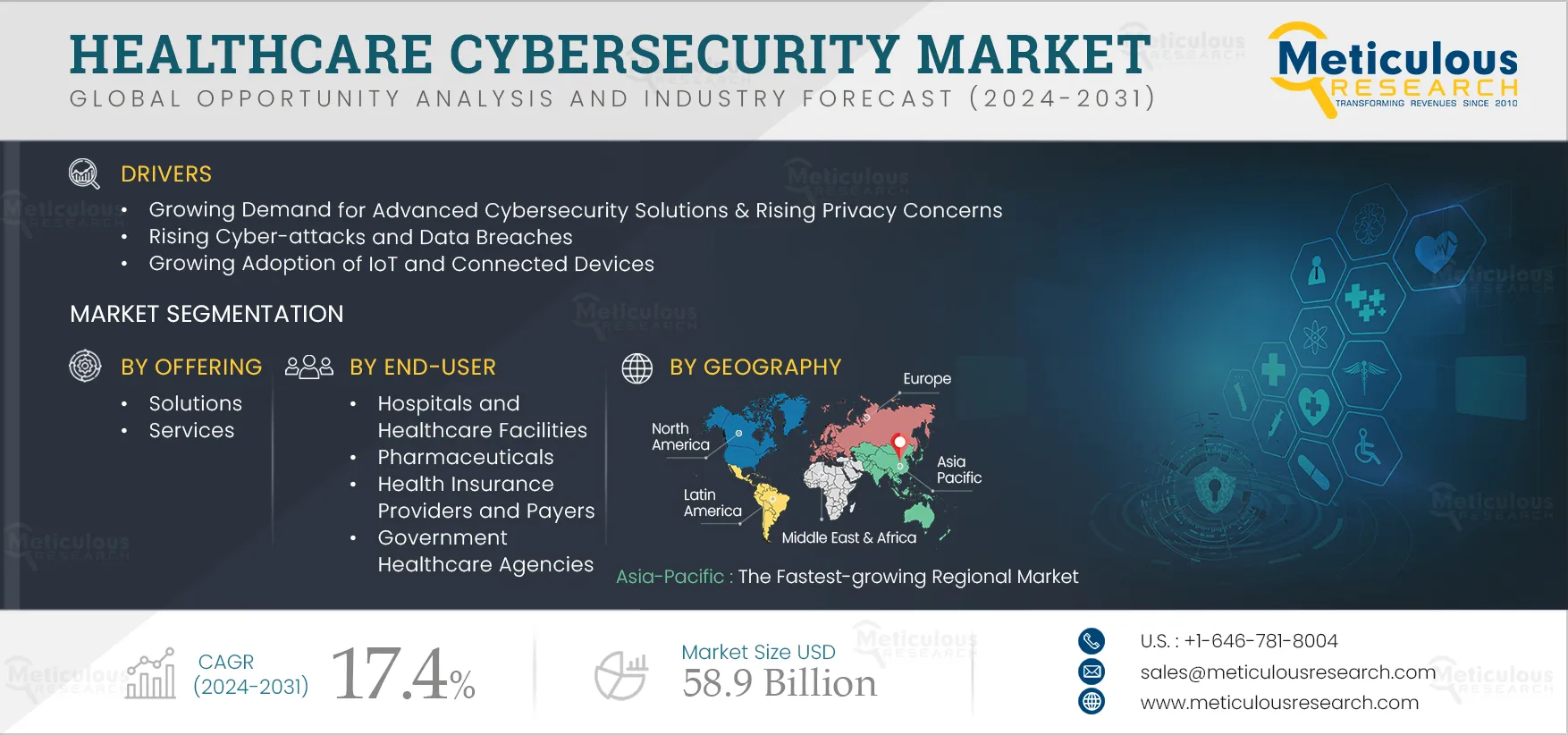The Healthcare Cybersecurity Market is expected to reach $58.9 billion by 2031, at a CAGR of 17.4% during the forecast period of 2024 to 2031. Healthcare organizations are switching to digital records and implementing new technologies, such as cloud computing, IoT, and 5G. However, the increasing adoption of digital technologies poses severe challenges and security concerns for the healthcare industry. Cybersecurity has emerged as one of the major concerns for healthcare organizations due to the growing need to minimize issues associated with data security and cyber threats. Factors driving the growth of this market include increasing demand for advanced cybersecurity solutions, increasing frequency & complexity of cyber threats, and growing adoption of IoT & connected devices across the healthcare sector. Furthermore, the increasing need for cloud-based security solutions across the healthcare sector, rising use of smartphones & connected devices, and growing adoption of 5G technology are expected to further contribute to the growth of the healthcare cybersecurity market over the coming years.
Here are the top 10 companies operating in Healthcare Cybersecurity Market
Cisco designs and sells a broad range of technologies that have been powering the Internet. Its developing intent-based technologies are continuously learning and adapting to provide customers with a highly secure, intelligent platform for their digital business across networking, security, collaborations, applications, and the cloud. The company’s core development areas include routing and switching and advanced technologies such as IP technology, Security, Home Networking, Optical Networking, Storage Area Networking, and Wireless technology With its subsidiaries and a strong distribution network, the company has its presence in various regions such as North America, Europe, Asia-Pacific, and the Middle East & Africa.
Palo Alto Networks, Inc. is a global cybersecurity leader. The company provides cybersecurity solutions with continuous innovation and the latest breakthroughs in analytics, AI, orchestration, and automation. The company operates in two business segments, namely product and subscription and support. Its cybersecurity products and services come under the subscription and support business segment. The company offers various solutions such as cloud security, SaaS security, network security, threat, and malware prevention, next-generation firewalls, enterprise security, cyber threat alliance, URL filtering, endpoint security, and cybersecurity canon. With its subsidiaries and a strong distribution network, the company has its presence in various regions such as the Americas, Europe, and the Middle East & Africa.
NortonLifeLock Inc.
NortonLifeLock Inc., formerly known as Symantec Corporation, is a global leader in consumer cyber safety and provides cybersecurity software and services. NortonLifeLock Inc. enterprise security products are now part of Broadcom, Inc. The company operates in two business segments: enterprise security and consumer digital safety. The company offers a big data security service, threat protection, antivirus and malware protection, information protection, identity protection, and cloud data protection. With its subsidiaries and a strong distribution network, the company has its presence in various regions such as the Americas, Europe, and Asia-Pacific.
Check Point Software Technologies Ltd.
Check Point Software Technologies Ltd. is a leading provider of cybersecurity solutions to corporate enterprises and governments globally. Check Point solutions protect customers from advanced target threats, ransomware, and malware. The company operates in three business segments: product & licenses, security subscription, software update & maintenance. Their cybersecurity products and services come under the security & subscription business segment. The company offers cybersecurity solutions such as network security, information security, mobile security, unified threat management, cyber threat prevention, security management, advanced threat prevention, cybersecurity research, cyber threat detection, endpoint security, remote access VPN, and security compliance. With its subsidiaries and a strong distribution network, the company has its presence in various regions such as North America, Europe, Asia-Pacific, and the Middle East & Africa.
Fortinet, Inc.
Fortinet, Inc. enables organizations to achieve security-driven networks with its innovative product portfolio and highest-performance security solutions. The company operates in three business segments, namely product, security subscription services, and technical support services, and others. Its cybersecurity products and services come under the product business segment. The company offers various solutions such as network security, web security gateways, enterprise firewalls, antivirus, email security, unified threat management, and intrusion prevention systems.
























